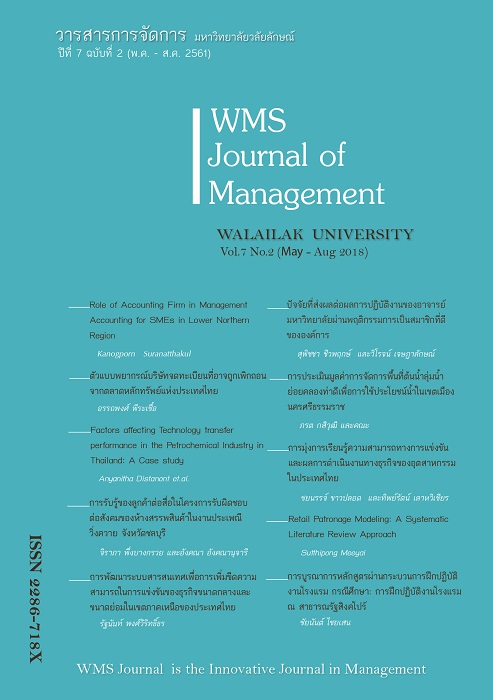Media Perception of Customers in Corporate Social Responsibility of Department Store in Buffalo Racing Festival Project Chonburi Province
Main Article Content
Abstract
This study had 3 objectives; 1). To study the degree of media perception on corporate social responsibility of department store 2).To study the relationship between media perception on corporate social responsibility and customer satisfaction 3). To study the mediating role of customer satisfaction between media perception on corporate social responsibility and behavioral intention. This study collected the data from 200 participants at a buffalo racing festival in Chonburi province. Purposive sampling was employed. Exploratory and confirmatory factor analysis were tested. Structural equation modeling was employed to test the hypotheses.
It was found that most of respondents were female and 31–40 years old. They hold a Bachelor degree and earn 20,001-30,000 baht per month. The degree of media perception on corporate social responsibility of cultural project in Thailand and customer satisfaction was at a high level. In addition, the degree of behavioral intention was at a very high level. Moreover, it was found that media perception on corporate social responsibility have a positive relationship with customer satisfaction. In addition, Point of event media has an indirect effect with behavioral intention through customer satisfaction.
Article Details
References
ณัฐนันท์ วงษ์ประเสริฐ (2014). กลยุทธ์การสื่อสาร เพื่อส่งเสริมการท่องเที่ยวงานประเพณีรับ บัวของอำเภอบางพลี จังหวัด สมุทรปราการ, วารสารบัณฑิตศึกษา มนุษยศาสตร์และสังคมศาสตร์, 3(2), 1-18.
เบญจวรรณ สุพันอ่างทอง (2555). การใช้อัต ลักษณ์ในการประชาสัมพันธ์การท่องเที่ยว ของจังหวัดอุดรธานี, วิทยานิพนธ์นิเทศ ศาสตร์มหาบัณฑิต, มหาวิทยาลัยธุรกิจ
บัณฑิต.
สถาพร สิงหะ (2556). การเปิดรับสื่อ การใช้ ประโยชน์ และความพึงพอใจกับการตัดสินใจ เลือกท่องเที่ยวแบบดำน้ำลึกของ
นักท่องเที่ยวชาวไทย, การค้นคว้าอิสระ นิเทศศาสตร์มหาบัณฑิต, มหาวิทยาลัย กรุงเทพ.
Ajzen, I., and Madden T. J. (1986). Prediction of goal-directed behavior: Attitudes, intentions, and perceived behavioral control, Journal of experimental social psychology, 22(5), 453-474.
Ajzen, I. (1991). The theory of planned behavior, Organizational Behavior and Human Decision Processes, 50 (2), 179–211.
Bagozzi, R. P., and Yi, Y. (1988). On the Structural Equations Models, Academy Of Marketing Science, 16(1), 74-94.
Bagozzi, R. P., and Yi, Y. (2012). Specification, Evaluation, and Interpretation of Structural Equation Models Journal of the Academy Of Marketing Science,
40(1), 8-34.
Browne, M. W. and Cudeck, R. (1993). Alternative ways of assessing model fit. In: Bollen, K. A. & Long, J. S. (Eds.)”, Testing Structural Equation Models, Beverly Hills, CA: Sage, 136–162.
Chang, Y.W., and Polonsky, M.J. (2012). The influence of multiple types of service convenience on behavioral intentions: The mediating role of consumer satisfaction in a Taiwanese leisure setting, International Journal of Hospitality Management, 31, 107-118
Cronin, J.J., Brady, M.K., and Hult, G.T.M. (2000). Assessing the Effects of Quality, Value and Customer Satisfaction on Consumer Behavioral Intentions in Service Environment, Journal of Retailing, 76(2), 193-218.
Dincer, B., and Dincer C. (2013). Corporate Social Responsibility Communication and Perception: Media and Risks, International Journal of Academic Research in Business and Social Science, 3(4), 207-222.
Fornell, C. and Larcker, D. F. (1981). Evaluating Structural Equation Models with Unobservable Variables and
Measurement Error, Journal of Marketing Research, 18 (1), 35-90.
Gianfranco, W., and Boris, B (2013). Exploring corporate ability and social responsibility associations as antecedents of customer
satisfaction cross culturally, Journal of Business Research, 66(8), 989-995.
Hair, J. F., Black, W. C., Babin, B.J., and Anderson, R. E. (2010). Multivariate Data Analysis (7th ed.). Upper Saddle River, New Jersey: Prentice Hall.
Iacobucci, D. (2010). Structural equation modeling: fit indices, sample size and Advanced topics, Journal of Consumer Psychology, 20, 90-98.
Jöreskog, K. and Sörbom, D. (1993), LISREL 8: Structural Equation Modeling with the SIMPLIS Command Language. Chicago, IL: Scientific Software International Inc.
Kaiser, H.F. and Rice, J. (1974) Little Jiffy, Mark Iv. Educational and Psychological Measurement, 34, 111-117.
Luo, X. and Bhattacharya C.B. (2006) Corporate Social Responsibility, Customer Satisfaction, and Market Value, Journal of Marketing, 70(4), 1-18.
MacCallum, R.C., Browne, M.W., and Sugawara, H.M. (1996). Power analysis and determination of sample size for covariance structure modeling, Psychological Methods, 1, 130-149.


